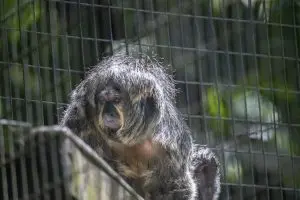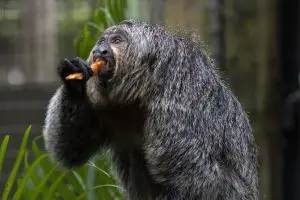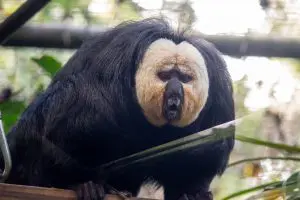

Chuckie is our longest saki monkey resident.
If you’ve visited the Zoo, you’ve likely met a lot of our more than 800 animal residents. Some animals are easy to spot, but others are often not as easy to see because of their habitat set up, their personalities or their sleep cycles among other things. We wanted to start a “Meet the Animals” section of our blog to introduce you to some of the residents that you may (or may not have) met yet!
With so many monkeys scurrying about our Rainforest Revealed loop, it can be easy to miss out on learning about them all. That’s why this month, we’re spotlighting our white-faced saki monkeys.
We are home to five saki monkeys: three of them have been in our care for years, and two of them have just recently moved to our Zoo!
Chuckette, nicknamed Chuckie, is one of our Rainforest loop’s longest animal residents—she’s been in our care for the past 18 years. Over this time, Chuckie gave birth to Suni and Stitch, two of our other sakis.

Meet 12-year-old Suni!
Interestingly, Suni and Stitch reside together in a shared habitat, but Chuckie lives separately from her offspring. When the three lived together, our keepers noticed Suni was very protective over her brother, Stitch, and it was everyone’s best interest to see if Chuckie could bond with any of our other monkeys instead.
Today, 21-year-old Chuckie lives with our golden-headed lion tamarins, Eduardo and Brissa, where she’s found a new best friend. Chuckie and Brissa quickly took a liking to each other and can often be seen sunbathing together, grooming each other and sharing their food.
Chuckie and Brissa’s relationship blossomed over the last year.
As for the saki siblings, Stitch has a bolder personality, so he is more audacious compared to his more passive sister, Suni. Overall, the two get along very well and keep each other in line, said Rainforest Revealed area supervisor Grace Scott.
All members of our saki family are curious and inquisitive in nature! From shredding paper bags to digging through pouches stuffed with treats, the monkeys stay busy with enrichment items. Their diets include veggies, greens, hard-boiled eggs, steamed sweet potatoes, and a variety of nuts and seeds—but peanuts are an all-time favorite.
“When keepers walk in and set down their diet container, the sakis are quick to bound over, lift off the lid, and rifle through the contents until they find whatever yummy nuts are included in their diet that day,” Grace said.
Another little-known fact is that saki monkeys are quite agile. You might often see them resting or calmly sitting in a ball, but those legs are surprisingly long, and they can leap a distance of up to thirty feet in their natural range. Who knew?!

Chuckie snacks on some of her diet food.
We also have two new sakis to introduce to you. Two-year-old Cecil came to us from another Association of Zoos and Aquariums (AZA)-accredited zoo as a non-breeding male pair for Chuckie.

Meet Cecil!
“While she [Chuckie] is quite content with Brissa, it is more natural for sakis to live in male-female pairs,” Grace said. “We are glad to be able to give Chuckie the opportunity to live with another saki and experience an even more improved social dynamic.”
Our other addition, a 6-year-old male saki monkey named Frankie, came to our Zoo as part of the AZA Species Survival Plan for the species. Though we have not yet received a female pair for Frankie, we hope to welcome one in the future to support the population of white-faced saki monkeys in AZA-accredited zoos.

Meet Frankie!
You can catch a glimpse of the newcomers on your next visit in our Rainforest Revealed loop! Cecil shares a habitat with Eduardo, Brissa and Chuckie, while Frankie is living in the adjacent habitat.